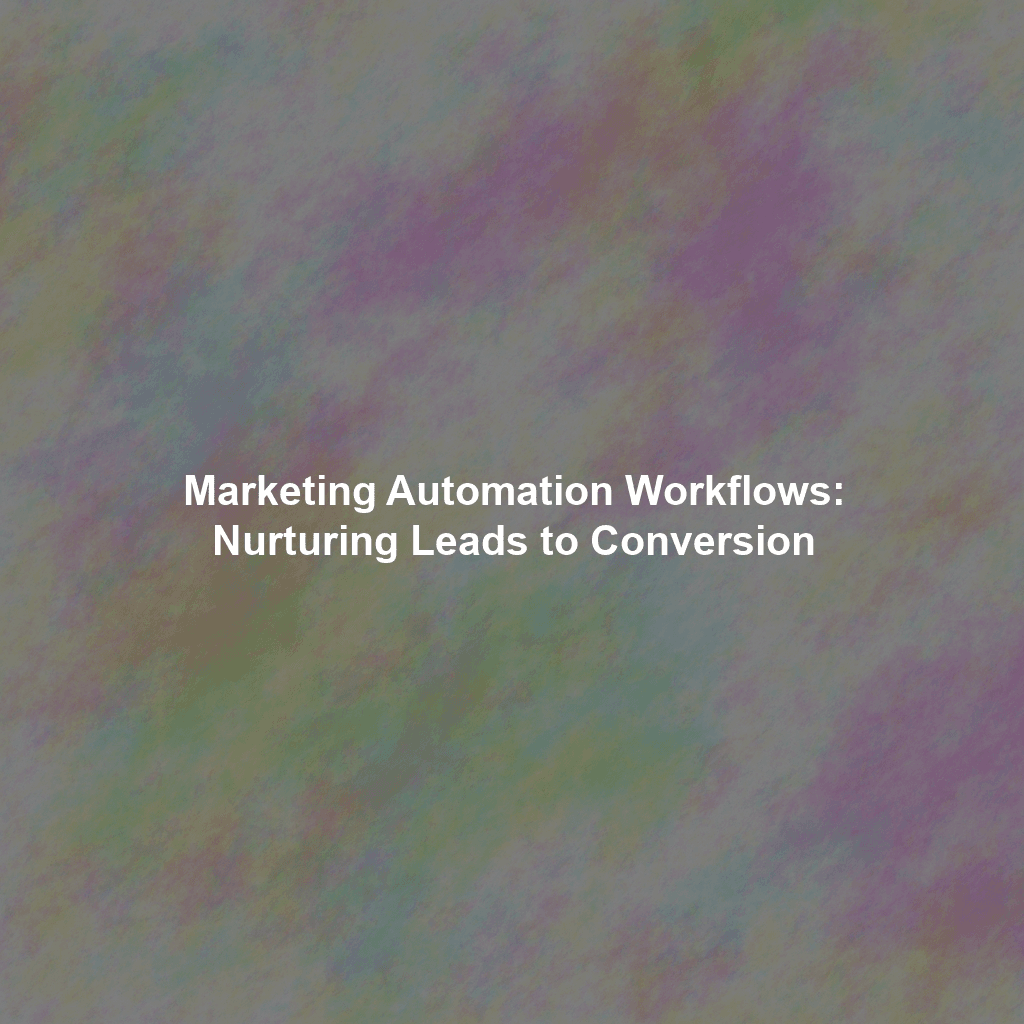Simply generating leads isn’t enough.
The real challenge lies in nurturing those leads, guiding them through the sales funnel, and ultimately converting them into paying customers. This is where marketing automation workflows come into play. These workflows are the unsung heroes of lead generation marketing, silently working behind the scenes to personalize communication, deliver relevant content, and move prospects closer to a purchase decision.
What Exactly is a Marketing Automation Workflow?
A marketing automation workflow is a pre-defined series of actions triggered by specific events or behaviors. Think of it as a digital assembly line for leads. Each stage is designed to deliver the right message, to the right person, at the right time. These workflows automate repetitive tasks, allowing your marketing and sales teams to focus on higher-value activities, like building relationships and closing deals. Key components of a marketing automation workflow include:
- Triggers: The event that starts the workflow (e.g., a lead subscribing to a newsletter, downloading an ebook, or visiting a specific webpage).
- Actions: The tasks performed automatically (e.g., sending an email, updating a lead’s score, adding a lead to a list, or assigning a task to a salesperson).
- Conditions: Rules that determine which path a lead takes within the workflow (e.g., if a lead opens an email, send them a follow-up email; if they don’t, try a different approach).
- Delays: Scheduled pauses between actions to avoid overwhelming leads and allow time for them to engage with your content.
Why are Marketing Automation Workflows Crucial for Lead Nurturing?
Lead nurturing is the process of building relationships with potential customers, guiding them through the buyer’s journey, and ultimately converting them into paying customers. Marketing automation workflows are the backbone of effective lead nurturing because they allow you to:
- Personalize Communication: Tailor your messaging based on a lead’s interests, demographics, and behavior. Generic emails are ignored; personalized messages get noticed.
- Deliver Relevant Content: Provide leads with information that addresses their specific needs and challenges, building trust and credibility.
- Automate Repetitive Tasks: Free up your team’s time to focus on more strategic activities, like building relationships with high-potential leads.
- Improve Lead Scoring: Track how leads interact with your content and assign scores based on their engagement, allowing you to prioritize the most promising prospects.
- Accelerate the Sales Cycle: Move leads through the sales funnel more quickly and efficiently by providing them with the information they need at each stage.
- Increase Conversion Rates: Convert more leads into paying customers by providing them with a personalized and engaging experience.
Building a Successful Marketing Automation Workflow: A Step-by-Step Guide
Creating effective marketing automation workflows requires careful planning and execution. Here’s a step-by-step guide to help you get started:
1. Define Your Goals
What do you want to achieve with your marketing automation workflows? Are you trying to generate more leads, increase conversion rates, or improve customer retention? Clearly define your goals before you start building your workflows. For example, a goal might be “Increase the number of MQLs (Marketing Qualified Leads) by 20% in the next quarter.”
2. Identify Your Target Audience
Who are you trying to reach with your workflows? Understanding your target audience is crucial for creating personalized and relevant content. Develop detailed buyer personas that outline their demographics, interests, pain points, and buying behaviors. Think about what motivates them, what questions they have, and where they spend their time online.
3. Map Out the Customer Journey
The customer journey is the path that leads take from initial awareness to becoming paying customers. Map out the key stages of the customer journey, including awareness, consideration, and decision. Identify the touchpoints where leads interact with your brand and the information they need at each stage. This helps you determine the content and actions you’ll need to include in your workflows.
4. Choose Your Marketing Automation Platform
Select a marketing automation platform that meets your needs and budget. Several platforms are available, each with its own strengths and weaknesses. Popular options include HubSpot, Marketo, Pardot, ActiveCampaign, and Mailchimp. Consider factors such as ease of use, features, integration capabilities, and pricing when making your decision.
5. Design Your Workflows
Now it’s time to design your workflows. Start with a simple workflow and gradually add complexity as you become more comfortable with the platform. Remember to focus on providing value to your leads at each stage of the workflow. Here are a few workflow examples:
Welcome Workflow
Trigger: New subscriber signs up for your email list.
Actions:
- Send a welcome email thanking them for subscribing.
- Offer a free resource or discount code.
- Introduce your brand and its values.
Lead Magnet Delivery Workflow
Trigger: Lead downloads a lead magnet (e.g., an ebook or whitepaper).
Actions:
- Send an email with a link to download the lead magnet.
- Send a follow-up email a few days later asking for feedback.
- Offer additional resources related to the lead magnet’s topic.
Abandoned Cart Workflow
Trigger: Customer abandons their shopping cart without completing the purchase.
Actions:
- Send an email reminding them of the items in their cart.
- Offer a discount or free shipping to encourage them to complete the purchase.
- Highlight the benefits of purchasing from your brand.
6. Create Compelling Content
Content is the fuel that drives your marketing automation workflows. Create high-quality, engaging content that addresses the needs and interests of your target audience. This includes blog posts, ebooks, whitepapers, case studies, videos, and infographics. Make sure your content is optimized for search engines and is easy to share on social media.
7. Test and Optimize Your Workflows
Once your workflows are up and running, it’s important to test and optimize them regularly. Track key metrics such as open rates, click-through rates, conversion rates, and unsubscribe rates. Use A/B testing to experiment with different subject lines, email copy, and calls to action. Continuously analyze your results and make adjustments to improve your workflows’ performance.
Essential Elements of High-Converting Marketing Automation Workflows
Beyond the basic steps, several elements contribute to the success of a high-converting marketing automation workflow:
- Segmentation: Divide your audience into smaller, more targeted groups based on demographics, interests, behaviors, and purchase history. This allows you to deliver more personalized and relevant content.
- Lead Scoring: Assign scores to leads based on their engagement with your content and their fit with your target audience. This helps you prioritize the most promising prospects and focus your sales efforts where they’ll have the biggest impact.
- Dynamic Content: Use dynamic content to personalize your emails and landing pages based on a lead’s profile. This could include their name, company, industry, or previous interactions with your brand.
- Multi-Channel Marketing: Integrate your marketing automation workflows with other channels, such as social media, SMS, and direct mail. This allows you to reach leads through their preferred channels and provide a consistent experience across all touchpoints.
- Integration with CRM: Connect your marketing automation platform with your customer relationship management (CRM) system. This allows you to track lead activity, update lead information, and seamlessly hand off leads to your sales team.
Avoiding Common Pitfalls in Marketing Automation
While marketing automation offers tremendous benefits, it’s important to avoid common pitfalls that can derail your efforts:
- Over-Automation: Don’t automate everything. Remember to maintain a human touch and build genuine relationships with your leads.
- Irrelevant Content: Don’t send leads content that isn’t relevant to their interests or needs. This will only annoy them and damage your brand’s reputation.
- Ignoring Analytics: Don’t set up your workflows and forget about them. Continuously monitor your results and make adjustments to improve your performance.
- Lack of Personalization: Don’t send generic emails that don’t speak to the individual needs of your leads. Personalization is key to engaging your audience and driving conversions.
- Poor Data Quality: Ensure your data is accurate and up-to-date. Inaccurate data can lead to wasted effort and missed opportunities.
The Future of Marketing Automation Workflows
Marketing automation is constantly evolving, with new technologies and strategies emerging all the time. In the future, we can expect to see even greater personalization, integration, and automation capabilities. Artificial intelligence (AI) and machine learning will play an increasingly important role in optimizing workflows and delivering more relevant and engaging experiences. As the digital landscape continues to change, marketing automation workflows will remain a critical component of successful lead generation marketing strategies.
Conclusion: Embrace Automation for Lead Nurturing Success
Marketing automation workflows are a powerful tool for nurturing leads, driving conversions, and growing your business. By understanding the principles of automation, carefully planning your workflows, and continuously optimizing your efforts, you can unlock the full potential of lead generation marketing and achieve remarkable results. Embrace the power of automation and watch your leads transform into loyal customers.
 Skip to content
Skip to content

